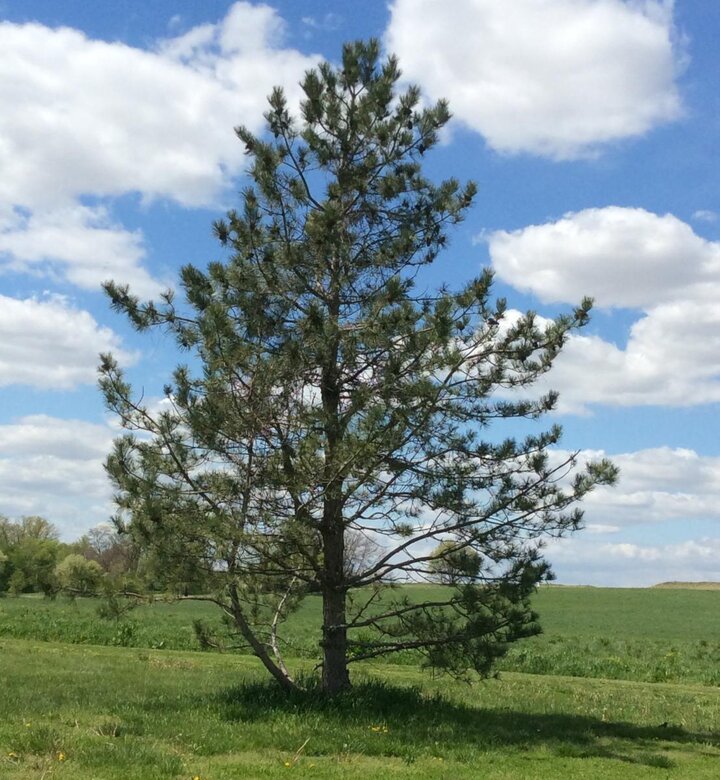Typical reddish brown infection lesions caused by Dothistroma on older Austrian pine needles. By Sarah Browning, Extension Educator
Dothistroma needle blight is one of the most common fungal diseases of pines in Nebraska, resulting in sparse trees with thin canopies. Older, inner needles are affected first causing premature needle drop. Many species of pine are affected by this disease, but in Nebraska it's found most commonly and causes the greatest amount of damage on Austrian and Ponderosa pine, both in windbreak and ornamental trees. Mugo pine, a common landscape shrub, can be infected, but Dothistroma is seldom seen in Scotch pine.

Symtoms
Fungal spores develop on dead sections of needles infected the previous year. During spring's wet, cool weather, spores are released and spread through wind or rain splash to new needles. Germinating spores enter the needles through natural openings and the infection process begins. Symptoms appear about three to four months after infection, usually becoming visible in late fall.
Symptoms are first seen as yellow or tan spots on older needles. These spots darken and become brown or reddish-brown then spread to form a band around the needle. These bands are often bordered by a yellow, chlorotic ring on each side. The fungus grows within these tissues, killing that portion of the needle beyond the lesion. Initially, the tip of the needle dies while the base remains green, but eventually as the disease progresses, the base of the needle also dies and the entire needle drops off the tree.
Lower branches of trees are most severely infected, due to reduced wind movement and slightly higher humidity levels near the ground, but the entire tree may show symptoms.
Reducing Dothistroma
Several management strategies can help minimize Dothistroma's impact on your trees. First, avoid planting susceptible pines in low lying or poorly drained areas. These areas often have higher natural humidity which promotes needle infection.
Promoting overall tree health and vigor goes a long way to lowering a tree's susceptibility. Control weeds and turf beneath trees. Maintain a 3-4 inch layer of wood chip mulch beneath trees, but do not mound it up around the tree's trunk. A flat, even layer is ideal, pulling the mulch back slightly so it does not lay against the tree's trunk.
Adjust landscape irrigation heads so water does not spray on your pine tree's needles. Frequent wetting increases the potential for needle infections.
Prune out dead branches in pines to reduce fungal innoculum.
Control
Infection on trees with a history of Dothistroma can be significantly reduced by making two fungicide applications. Copper fungicides work well, are very common and can usually be found at most nurseries and garden centers that have a good chemical selection. They also have low human toxicity and low environmental impact.
Look for liquid or fixed copper formulations, such as Bonide Copper Fungicide, Monterey Liqui-Cop, Southern Ag Liquid Copper Fungicide and any other copper fungicide labeled for use on evergreen trees. Many formulations of these products are available from a variety of manufacturers, just make sure pine trees are a labeled site for the product you buy. Read and follow all label directions carefully before application.
The first application is usually done in mid-May and protects last year's new growth. The second application, which protects this year's new growth, is made after new growth is complete and needles are fully expanded; usually around mid- to late June. Spray applications to large trees are difficult, so if you don't have the equipment to reach the top of the tree that's OK. Focus on getting good coverage on the lowest 6-8 feet of the canopy.
Annual applications of fungicide are not always necessary to control this disease. Monitor susceptible pines for symptoms of infection each year. If infection occurs during a year in which fungicide has not been applied, and is severe enough to warrant control, then fungicide can be applied the next year with confidence that good control will be obtained. If little or no infection occurs during a year when fungicide was not applied, then spraying can be skipped for another year.
For more information, refer to:
Diseases of Evergreen Trees, Nebraska Forest Service.
Dothistroma Needle Blight of Pine, University of Nebraska- Lincoln Extension
Images by Sarah Browning, Nebraska Extension.
- Typical reddish brown infection lesions caused by Dothistroma on older Austrian pine needles.
- A sparse pine canopy, as on this Austrian pine, is often the result of early needle loss due to diseases like Dothistroma.
Search Our Archive
Associated Video
Spring Pine Diseases
Nebraska Extension Plant Diagnostician Kevin Korus talks about Diplodia needle blight and Dothistroma tip blight and how to control them.<br />
<br />